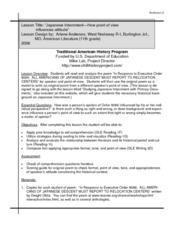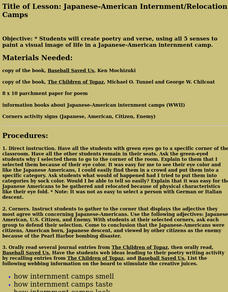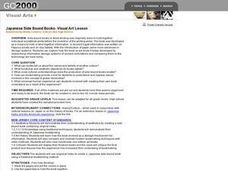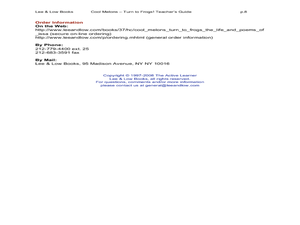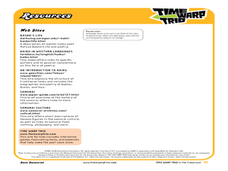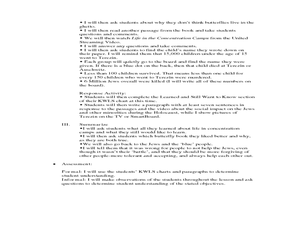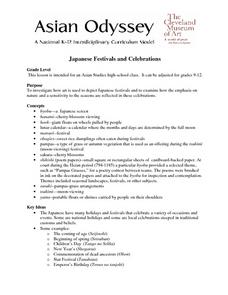Curated OER
Japanese Internment--How Point of View Influences Attitude
How does background and experience influence one's point of view? Dwight Okita's famous poem about the Japanese internment is the text used to explore this essential question. Class members study primary documents to gain the necessary...
Curated OER
THE OCCUPATION OF KOREA BY JAPANESE IMPERIALIST FORCES
Students read and respond to a history of Korea. In this occupation lesson, students work in groups to research the effects of Japanese occupation and create an illustrated timeline. Students listen to a lecture and write an acrostic....
Curated OER
The Art and History of Japanese Calligraphy
Chinese and Japanese calligraphy is beautiful and significant in both culture and tradition. Engage your class in this expressive fine art form through a lesson on using, holding, and creating brush strokes common to Japanese writing...
Curated OER
A Journey To Japan Through Poetry
Third graders gain an appreciation for writing, analyzing, reading and listening to poetry, viewing poems as a motivation for studying Japanese culture and tradition. They study and create their own haiku and tanka poems with illustrations.
Curated OER
Japanese-American Internment/Relocation Camps
Learners create poetry and verse, using all 5 senses to paint a visual image of life in a Japanese-American internment camp.
Curated OER
The Poetry of Chinoiserie
Students study Asian works of art and Japanese haiku. They then take this knowledge and create an original haiku in response to other works of art.
Curated OER
Do You Haiku? We Do!
Third graders try their hands at writing Haiku, a form of Japanese poetry. Haiku is usually 17 syllables in three-line form. This engaging instructional activity has many excellent worksheets and website imbedded in the plan. They share...
Curated OER
Oceans-A Fact Haiku
Students create haiku poems. In this poetry lesson, students listen to the sound of the ocean from an audio file and write a haiku poem about oceans.
Curated OER
Gyotaku Lesson Plan
Students study the Japanese art of fish painting called Gyotaku while examining the lifestyle of Japanese fishermen at the end of the Edo period. They make a Gyotaku fish print and write a haiku poem using the proper number of syllables...
Curated OER
Under the Blood-Red Sun
Fifth graders explore U.S. history by reading an award winning book about World War II. In this Japanese internment camp lesson, 5th graders read the book Under the Blood-Red Sun and discuss the entrapment of Japanese-Americans on our...
Curated OER
Do You Haiku?
After examining several Haiku and noting characteristics of the form, class members create five of their own poems. Use this resource for extra practice or review.
Curated OER
You Too Can Haiku: How to Write a Haiku
Students explore language arts by writing their own poems. In this haiku lesson, students investigate the Japanese culture and their beautiful music, poetry and art. Students count the syllables in every line of a haiku poem and write...
Curated OER
Paper Cranes
Paper folding is a great art form that can be incorporated into cultural, mathematic, and art lessons. This resource includes the full instructions needed to fold a paper crane, as well as a Haiku poetry idea. Tip: This activity would be...
Curated OER
Sadako: A Tribute to a Girl with Cancer
Pupils explore the story of Sadako, a young girl, who had leukemia as a result of a bomb being dropped on Hiroshima in 1955. They create a chain of paper cranes and design a fund-raising event. They write poems in the Japanese style of...
Curated OER
My Secret War: Lesson 14
Fifth graders explore the civilian role during World War II. In this social studies instructional activity, 5th graders write an "I Am an American" poem from the perspective of various Americans during the war.
Curated OER
Japanese Side Bound Books
Students create Japanese side-bound books using traditional bookbinding methods and original Haikus in this Art lesson for the High School classroom. The lesson can be modified for any grade level and can be accomplished in two class...
Curated OER
Cool Melons Turn to Frogs
Third graders become familiar with the poetry of Issa. In this haiku lesson, 3rd graders recognize the format of a haiku and learn about the life of Issa (the poet) through focused questions, vocabulary and reading responses. Students...
Curated OER
Sam Samurai
Students study the history and culture of 17th century Japan by examining samurai. They review the format of haiku poetry and examine renga poetry. They examine Kamishibai, the Japanese storytelling form and apply it five facts they...
Curated OER
Cloud Haiku
Students listen as a haiku is read by the teacher, determining what season is being portrayed in the poem. Students work together as a class and create a model haiku, then complete a worksheet, completing their own poem. Students will...
Curated OER
Nature and Haiku Poetry
Students compose haiku poems and recognize how cultures value nature and
natural forces through the study of Japanese poetry. This instructional activity includes a bibliography of resources.
Denver Art Museum
Descriptive Haiku
Even though this is technically an art activity, haiku poetry is actually the main focus! Learners view photographs of Japanese tea caddies. They list five descriptive words for the caddies, then write haiku poems using the caddies as...
Curated OER
Political and Social Impact of World War II
Sixth graders study the life in Jewish ghettos during World War II and learn about tolerance and compassion. In this WWII lesson, 6th graders discuss Jewish ghettos but with a mistreatment of the kids with stickers to signify the Jewish...
Curated OER
Cinquain Poems
Students write five-line, diamond shaped poems that are very easy to write then submit one through an automatic PIZZAZZ form.
Curated OER
Japanese Festivals and Celebrations
Students investigate the importnce of celebrations anf festivals in Japanese culture and then create a story based upon an image from the lesson. Resource links are provided for images of events.
